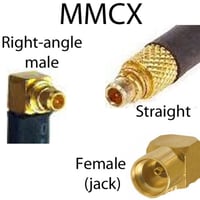MHF Series: MHF1 MHF3 MHF4
MHF Connector Series MHF1, MHF3, MHF4 Specifications and Applications Compared
Applications of MHF Connectors & Cables
The MHF series of RF micro-connectors (mating heights listed below are the maximum):
- MHF1 (also known as MHF) has a Mating Height of 2.5mm
- MHF2 has a Mating Height of 2.1mm.
- MHF2 is extremely rarely used and for this reason, we do not carry cables with MHF2 connectors
- MHF3 has a Mating Height of 1.6mm
- MHF4 has a Mating Height of 1.2mm
MHF3 connector is compatible with a W.FL connector while MHF2 connector is equivalent of. The MHF4 cable connector is the smallest while MHF1 connector is the largest which is comparable to a U.FL connector.
MHF connectors are the smallest type of RF micro-connectors for coaxial antenna cables. MHF-series connectors offer a controlled 50 impedance connection and stable frequency of 0 to 6 GHz. These connectors are made of copper alloy, and gold plated which enhances their performance. Just like MMCX connector, MHF connector allows 360-degree mounting of the cable which makes it highly flexible to use. MHF can be terminated with a 1.13 mm and 1.32 mm coaxial cable.
The high operational frequency range and small size make MHF connectors ideal for use as wireless LAN antenna and Bluetooth application in mobile phones, GPS, wireless communication devices, notebook computer, access point, test points, and gaming equipment among other applications.
MHF Series of RF Connectors: A Deep Dive into MHF1, MHF3, and MHF4
Coaxial Cable Types for MHF Cable Assemblies
RF connectors, like those in the MHF series, are typically coupled with coaxial cables. These cables have been designed to carry high-frequency electrical signals with minimal losses. Specifically:
- MHF1 is compatible with 1.13mm, 1.32mm, 1.37mm, RG174 an dRG178 coaxial cable types.
- MHF3 requires the smallest diameter coax which is 0.81mm.
- MHF4 is best matched with 1.13mm and can be used with the very slim 0.81mm coax, making it suitable for ultra-miniaturized devices.
Suitability for Specific IoT Applications
IoT devices, due to their diverse nature, require varying levels of power and data transfer rates. Thankfully, the MHF series caters to a broad spectrum:
- MHF1: Ideal for larger IoT devices such as smart home appliances where space isn't as constrained.
- MHF3: Finds its home in medium-sized IoT gadgets like wearable fitness trackers.
- MHF4: Best suited for ultra-small IoT modules, including some of the advanced medical wearables and drone modules.
Compatible Wireless Technologies
One of the strengths of the MHF series lies in its compatibility with numerous wireless technologies, making them an indispensable part of the IoT ecosystem:
- LTE
- GSM
- Wi-Fi (including Wi-Fi 6 and beyond)
- Bluetooth (including BLE)
- Zigbee
- NFC
- UWB and more.
Key Features
- Miniaturization: Allows for compact design, which is particularly essential for IoT devices.
- Broad Frequency Range: Typically, from DC to 6 GHz, facilitating diverse applications.
- Durability: They can withstand multiple mating cycles, promising longevity.
- Impedance Matching: Typically designed for 50 ohms, ensuring minimal signal reflection and maximum power transfer.
Materials Composition
The MHF connectors predominantly feature:
- Contact: Gold plated, ensuring low resistance and longevity.
- Insulator: Typically made of a high-frequency plastic like PTFE.
- Body: Usually comprised of a combination of metals, often gold or nickel-plated, for durability and conductivity.
Types & Applications
- MHF1: Predominantly in LTE devices, notebooks, and larger smart gadgets.
- MHF3: Often found in tablets, smartwatches, and medium-sized IoT devices.
- MHF4: Primarily in smartphones, ultra-miniature IoT devices, and high-frequency applications.
The rapid evolution of technology has been accompanied by a proliferation of connectivity demands in various domains. Enter the MHF series of RF connectors – an unsung hero in the world of miniature connectors. This series, consisting of types such as MHF1, MHF3, and MHF4, brings the promise of seamless connectivity, especially for IoT applications.











